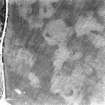Benbecula, Gramisdale
Stone Circle (Neolithic) - (Bronze Age)
Site Name Benbecula, Gramisdale
Classification Stone Circle (Neolithic) - (Bronze Age)
Alternative Name(s) Gramsdale
Canmore ID 10186
Site Number NF85NW 2
NGR NF 82498 56139
Datum OSGB36 - NGR
Permalink http://canmore.org.uk/site/10186
- Council Western Isles
- Parish South Uist
- Former Region Western Isles Islands Area
- Former District Western Isles
- Former County Inverness-shire
NF85NW 2 8250 5614.
(NF 8250 5614) Stone Circle (NR) (Remains of)
OS 6"map, Inverness-shire, 2nd ed., (1903)
The remains of a stone circle are visible about 100 yards north of the stone circle SE of Gramsidale (NF85NW 3) and within 250 yards of the southern shore of the North Ford, comprising a standing stone 5ft high and two prostrate stones, lying about 42ft WNW and 37ft SW.
RCAHMS 1928.
Henshall notes the stumps or fragments of ten stones besides the standing stone, giving a diameter of about 100ft. There is no sign of a cairn inside the circle but there is a prostrate slab to the east of the centre of the circle.
Information from MS of A S Henshall 'Chambered Tombs of Scotland, Vol.2, 62.
The remains of the stone circle are as described by Henshall.
Resurveyed at 1:2500.
Visited by OS (R D) 8 May 1965.
Field Visit (15 July 1915)
Stone Circle, Gramisdale.
About 1000 yards north of the last described circle (NF85NW 3), and within 250 yards of the southern shore of the North Ford, on a slight eminence, are an erect monolith and two prostrate stones, the remains of a stone circle. The standing stone is a thin, blunt pointed pillar measuring 5 feet in height, 3 feet 9 inches in width at its widest part about half-way up the stone, and 8 inches in thickness; the other stones, measuring 7 feet 9 inches by 4 feet 8 inches, and 4 feet 9 inches by 4 feet 6 inches, lie 41 feet 9 inches to the west-north-west (315° mag.) and 37 feet 4 inches to the south-west (220° mag.) respectively.
RCAHMS 1928, visited 15 July 1915.
OS map: South Uist xlvi.
Field Visit (2 March 2010)
What may be the remains of a stone circle measuring about 24m in diameter stand on a low knoll in an area of pasture; there are faint traces of the furrows of cultivation rigs extending from N to S through the interior. The only stone remaining upright is on the E, standing in a slight hollow with several loose stones gathered around its foot. It is a cleaved slab with its flatter WNW side facing into the interior and measures 0.8m in breadth by 0.18m in thickness at the base, but expands to 1.15m in breadth at a point about 1m above the ground, before narrowing to a rounded top at a height of 1.4m. Clockwise from this position, several stones lie prostrate and displaced: one small slab 1.4m long lies 7m to the SSW; two stones lie 14m to the WSW, both 1.7m long; another lies 12m to the NW and is 2.1m long and 1.4m broad; a lump of outcrop is visible 16m to NNW; and 13.5m to the N, there is a slab 1.2m square and 0.4m thick. Further outcrops and smaller stones can be seen around the knoll to the W.
Visited by RCAHMS (ARG,SPH) 2 March 2010


























